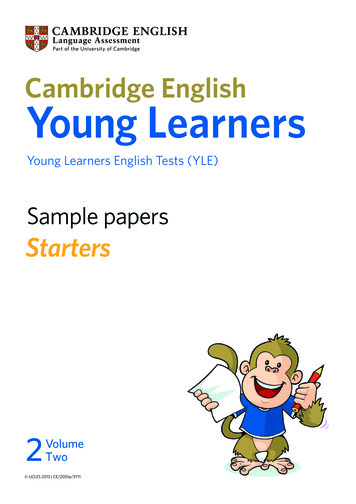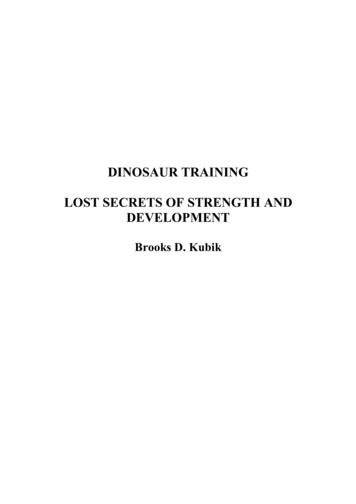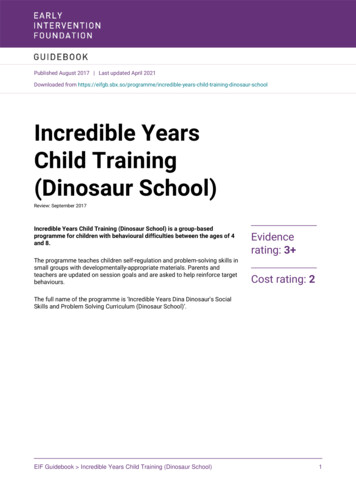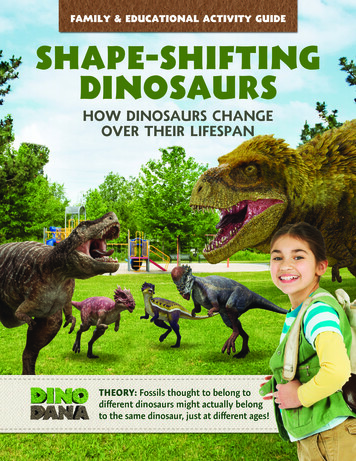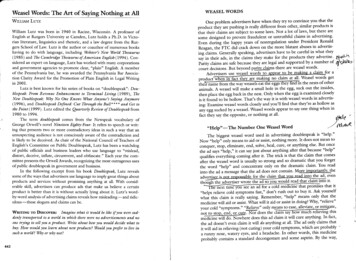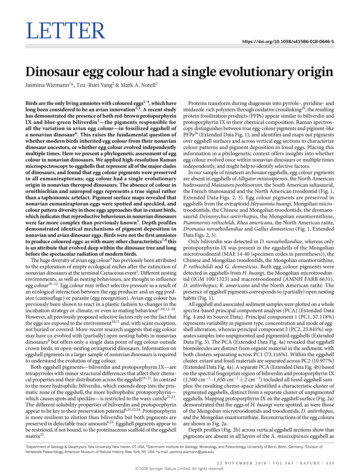
Transcription
osaur egg colour had a single evolutionary originJasmina Wiemann1*, Tzu-Ruei Yang2 & Mark A. Norell3Birds are the only living amniotes with coloured eggs1–4, which havelong been considered to be an avian innovation1,3. A recent studyhas demonstrated the presence of both red-brown protoporphyrinIX and blue-green biliverdin5—the pigments responsible forall the variation in avian egg colour—in fossilized eggshell ofa nonavian dinosaur6. This raises the fundamental question ofwhether modern birds inherited egg colour from their nonaviandinosaur ancestors, or whether egg colour evolved independentlymultiple times. Here we present a phylogenetic assessment of eggcolour in nonavian dinosaurs. We applied high-resolution Ramanmicrospectroscopy to eggshells that represent all of the major cladesof dinosaurs, and found that egg colour pigments were preservedin all eumaniraptorans: egg colour had a single evolutionaryorigin in nonavian theropod dinosaurs. The absence of colour inornithischian and sauropod eggs represents a true signal ratherthan a taphonomic artefact. Pigment surface maps revealed thatnonavian eumaniraptoran eggs were spotted and speckled, andcolour pattern diversity in these eggs approaches that in extant birds,which indicates that reproductive behaviours in nonavian dinosaurswere far more complex than previously known3. Depth profilesdemonstrated identical mechanisms of pigment deposition innonavian and avian dinosaur eggs. Birds were not the first amniotesto produce coloured eggs: as with many other characteristics7,8 thisis an attribute that evolved deep within the dinosaur tree and longbefore the spectacular radiation of modern birds.The huge diversity of avian egg colour9 has previously been attributedto the exploration of empty ecological niches after the extinction ofnonavian dinosaurs at the terminal Cretaceous event1. Different nestingenvironments, as well as nesting behaviours, are thought to influenceegg colour10–12. Egg colour may reflect selective pressure as a result ofan ecological interaction between the egg producer and an egg predator (camouflage) or parasite (egg recognition). Avian egg colour haspreviously been shown to react in a plastic fashion to changes in theincubation strategy or climate, or even in mating behaviour1,10,12–18.However, all previously proposed selective factors rely on the fact thatthe eggs are exposed to the environment10,11 and, with scant exception,not buried or covered. More-recent research suggests that egg colourmay have co-evolved with (partially) open nesting habits in nonaviandinosaurs6 but offers only a single data point of egg colour outsidecrown birds, in open-nesting oviraptorid dinosaurs. Information oneggshell pigments in a larger sample of nonavian dinosaurs is requiredto understand the evolution of egg colour.Both eggshell pigments—biliverdin and protoporphyrin IX—aretetrapyrroles with minor structural differences that affect their chemical properties and their distribution across the eggshell19–22. In contrastto the more hydrophilic biliverdin, which extends deep into the prismatic zone of the eggshell, the more hydrophobic protoporphyrin—which causes spots and speckles—is restricted to the waxy cuticle21,23.The different solubility properties of biliverdin and protoporphyrinappear to be key to their preservation potential6,21,22,24. Protoporphyrinis more resilient to elution than biliverdin but both pigments arepreserved in detectable trace amounts6,24. Eggshell pigments appear tobe restricted, if not bound, to the proteinaceous scaffold of the eggshellmatrix25.Proteins transform during diagenesis into pyrrole-, pyridine- andimidazole-rich polymers through oxidative crosslinking26; the resultingprotein fossilization products (PFPs) appear similar to biliverdin andprotoporphyrin IX in their chemical composition. Raman spectroscopy distinguishes between true egg-colour pigments and pigment-likePFPs26 (Extended Data Fig. 1), and identifies and maps out pigmentsover eggshell surfaces and across vertical egg sections to characterizecolour patterns and pigment deposition in fossil eggs. Placing thisinformation in a phylogenetic context offers insights into whetheregg colour evolved once within nonavian dinosaurs or multiple timesindependently, and might help to identify selective factors.In our sample of nineteen archosaur eggshells, egg colour pigmentsare absent in eggshells of Alligator mississipiensis, the North Americanhadrosaurid Maiasaura peeblesorum, the South American saltasaurid,the French titanosaurid and the North American troodontid (Fig. 1,Extended Data Figs. 2, 3). Egg colour pigments are preserved ineggshells from the oviraptorid Heyuannia huangi, Mongolian microtroodontids, the Chinese and Mongolian troodontids, the dromaeosaurid Deinonychus antirrhopus, the Mongolian enantiornithine,Psammornis rothschildi, Rhea americana, the North American ratite,Dromaius novaehollandiae and Gallus domesticus (Fig. 1, ExtendedData Figs. 2, 3).Only biliverdin was detected in D. novaehollandiae, whereas onlyprotoporphyrin IX was present in the eggshells of the Mongolianmicrotroodontid (MAE 14-40 (specimen codes in parentheses)), theChinese and Mongolian troodontids, the Mongolian enantiornithine,P. rothschildi and G. domesticus. Both egg colour pigments weredetected in eggshells from H. huangi, the Mongolian microtroodontid (IGM 100/1323) and macrotroodontid (AMNH FARB 6631),D. antirrhopus, R. americana and the North American ratite. Thepresence of eggshell pigments corresponds to (partially) open nestinghabits (Fig. 1).All eggshell and associated sediment samples were plotted on a wholespectra-based principal component analysis (PCA) (Extended DataFig. 4 and its Source Data). Principal component 1 (PC1, 57.118%)represents variability in pigment type, concentration and mode of eggshell alteration, whereas principal component 2 (PC2, 23.841%) separates samples into unpigmented and pigmented eggshells (ExtendedData Fig. 5). The PCA (Extended Data Fig. 4a) revealed that eggshellbiomolecules are distinct from organic material in the sediment, withboth clusters separating across PC1 (73.116%). Within the eggshellcluster, extant and fossil materials are separated across PC2 (10.977%)(Extended Data Fig. 4a). A separate PCA (Extended Data Fig. 4b) basedon the spectral fingerprint region of biliverdin and protoporphyrin IX(1,500 cm 1–1,650 cm 1 2 cm 1) included all fossil eggshell samples: the resulting chemo-space identified a characteristic cluster ofpigmented eggshells, distinct from a separate cluster of unpigmentedeggshells. Mapping protoporphyrin IX on the eggshell surface (Fig. 2a)demonstrated that the eggs of H. huangi were spotted, as were thoseof the Mongolian microtroodontids and troodontids, D. antirrhopus,and the Mongolian enantiornithine. Reconstructions of the egg coloursare shown in Fig. 2a.Depth profiles (Fig. 2b) across vertical eggshell sections show thatpigments are absent in all layers of the A. mississipiensis eggshell as1Department of Geology & Geophysics, Yale University, New Haven, CT, USA. 2Steinmann Institute for Geology, Mineralogy, and Paleontology, University of Bonn, Bonn, Germany. 3Division ofVertebrate Paleontology, American Museum of Natural History, New York, NY, USA. *e-mail: jasmina.wiemann@yale.edu2 2 N O V E M B ER 2 0 1 8 V O L 5 6 3 N A T U RE 5 5 5 2018 Springer Nature Limited. All rights reserved.
RESEARCH LetterRelative intensity (AU)Alligator mississipiensisNorth American Maiasaura peeblesorumNorth American Maiasaura peeblesorum31South American saltasauridFrench titanosaurid2Heyuannia huangiMongolian microtroodontidMongolian microtroodontid4North American troodontidChinese troodontid5Mongolian troodontidMongolian troodontidDeinonychus antirrhopus6Mongolian enantiornithineAlgerian Psammornis rothschildiRhea americanaOrnithoid ratite eggshell?7Dromaius novaehollandiaeGallus domesticus500Raman shift (cm–1)1,0001,5002,0002,5003,0005 mmFig. 1 Stacked Raman spectra and ancestral state reconstructionon a pruned supertree. The Raman spectra represent bands at 200–3,000 cm 1 2 cm 1, from 6 accumulations and 20 s of exposure; spectraare baselined and normalized. Ancestral state reconstruction is basedon published phylogenies8,28,29 (n 19 sampled taxa), and maximumparsimony. The internal nodes are (1) Archosauria, (2) Dinosauria,(3) Ornithischia, (4) Saurischia, (5) Eumaniraptora, (6) Paraves and(7) Aves. The egg icon in the phylogeny labels Eumaniraptora. All terminaltaxa are represented by an icon indicating egg shape, and an example ofreconstructed colour. If pigments are present, the area below the spectralfunction is coloured in blue (biliverdin) or orange (protoporphyrin IX),and all pigment bands are labelled with either blue (biliverdin) or red(protoporphyrin IX) dots. Relative Raman band intensities may varyowing to differential preservation. Photographs show the samples and nesticons encode three nesting strategies: buried, (partially) open ground andopen tree nesting. AU, arbitrary units.well as on the surface. The pigment stratification in D. novaehollandiae, D. antirrhopus, the Mongolian troodontid (AMNH FARB6631) and H. huangi appears almost identical: in these samples,both pigments show a peak in concentration in the eggshell cuticle and increased concentration values through the entire prismatic zone. In the eggshells of G. domesticus and the Mongolianenantiornithine, the protoporphyrin IX signal reaches a peak in theorganic and mineralized cuticle and extends into the uppermostprismatic zone. This is consistent with the absence of biliverdin inthe high-resolution point measurements of these samples. Only theMongolian troodontid (AMNH FARB 6631) produced a differentsignal in the depth profiles to those obtained in the point measurements: in addition to very weak bands assigned to protoporphyrinIX in the point measurements for this eggshell, the depth profilerevealed a weak biliverdin signal that is apparently restricted to thedeeper eggshell layers. In contrast to the depth profiles in fresh D.novaehollandiae and G. domesticus eggshells, all fossil samples showedminor evidence of pigment elution (Fig. 2b). Only the Mongolian5 5 6 N A T U RE V O L 5 6 3 2 2 N O V E M B ER 2 0 1 8 2018 Springer Nature Limited. All rights reserved.
Letter RESEARCHHeyuanniaaMicrotroodontid TroodontidTroodontidDeinonychus EnantiornithineDromaiusGallus200 μmbAlligatorHeyuanniaMicrotroodontid TroodontidTroodontidDeinonychus EnantiornithineDromaiusGallusEggshell pigment depth pzpzpzpzpzpzmtmtmtmtmtmtmtRel. amountsRel. amountsRel. amounts Rel. amountsRel. amountsProtoporphyrin derivativescRel. amountsBiliverdin derivativesmtmtmt detachedRel. amounts Rel. amounts Rel. amountsProteins derivativesBiomolecule colour changes through ized5 cmFig. 2 Egg colour reconstruction. a, Top, eggshell-pigment surface maps.n 8; selection criteria were pigment presence (Fig. 1) and sufficientsurface exposure. Protoporphyrin was mapped (1,350 cm 1 2 cm 1,2 accumulations, 5 s of exposure) with three independent repetitions,which yielded similar results. Increased signal intensity (yellow) is relativeto the lowest signal intensity (black, which equals background noise in theabsence of protoporphyrin IX). Bottom, egg reconstructions that combineinformation from panels above, b and Fig. 1 into a range of potentialcolours for the fossil eggshells. From left to right: H. huangi, Mongolianmicrotroodontid (MAE 14-40), Mongolian troodontid (AMNH FARB6631), Mongolian troodontid (IGM 100/1003), D. antirrhopus, Mongolianenantiornithine, D. novaehollandiae and G. domesticus. b, Pigment depthprofiles across vertical sections of eggs from A. mississipiensis, plus thetaxa shown in a (n 9 specimens). Depth profiles were repeated threetimes independently, which yielded similar results. Photographs and depthprofiles are not at the same scale. The distribution of protoporphyrin IX(red), biliverdin (blue) and proteinaceous matter (grey) is based on Ramanpoint measurements and line maps (1,166 cm 1 2 cm 1). Droplet iconsindicate pigment elution. oc, organic cuticle; mc, mineralized cuticle; pz,prismatic zone; mt, membrana testacea. c, Visualization of gradual colourchange of eggshell pigments and proteinaceous matter through time, basedon observations of eggshells (D. novaehollandiae and Casuarius casuarius)and on a previous study26.microtroodontid appeared to have experienced very intense pigment elution, as can be seen by comparing its depth profile to that ofG. domesticus (protoporphyrin IX only, Fig. 2b). No trace of eggshellpigments was found in any of the sediment samples that surroundedthe eggshells (Extended Data Fig. 6).We infer endogeneity of the eggshell pigments detected on the basisof a number of criteria: the required 22 Raman band matches for biliverdin and protoporphyrin IX (Extended Data Fig. 1), the statisticallysupported separation of unpigmented and pigmented fossil eggshells(Extended Data Fig. 4b), the exclusion of pigment-like PFPs in theRaman-band identification (Extended Data Fig. 1), the similaritybetween pigment depth profiles in fresh and fossil eggshells (Fig. 2b)and the absence of pigments in the host sediments (Extended DataFigs. 4a, 6).The phylogenetic distribution of egg colour within this archosaursample supports a single evolutionary origin within nonavian theropoddinosaurs (Fig. 1). The homology between nonavian dinosaur and birdeggshell colour is further supported by an identical mode of eggshell2 2 N O V E M B ER 2 0 1 8 V O L 5 6 3 N A T U RE 5 5 7 2018 Springer Nature Limited. All rights reserved.
RESEARCH Letterpigment deposition. This is based on a comparison of the depth profilesof eggshell pigments in nonavian eumaniraptorans with those ofD. novaehollandiae and G. domesticus, which reveals that the stratification of pigments appears almost identical (Fig. 2) both among taxathat incorporate biliverdin and protoporphyrin IX and among taxa thatincorporate only protoporphyrin IX. Only a larger sample of eggshellfrom taxa deeper in the tree will answer the question of whether eggcolour is a true eumaniraptoran synapomorphy, or whether it evolvedin more-basal theropods.The North American troodontid is the only sample within eumaniraptorans8 that did not yield any colour signal. Although ornithischianM. peeblesorum eggshells from the same locality in the Two MedicineFormation also lacked colour, ornithoid ratite eggshells from comparable beds preserve traces of both biliverdin and protoporphyrin.We therefore interpret the absence of egg colour pigments in thesetroodontid eggshells (YPM VP PU 023259) as real, rather than taphonomic. Secondary reduction of egg colour is well-documented inmodern birds and appears to be associated with increased sunlightexposure—an adaptation against overheating as seen, for example, inostriches—nocturnality or cave breeding12.Our reconstructed egg colours (Fig. 2a) reflect the different preservation potential of biliverdin and protoporphyrin IX. We combineddata from the high-resolution Raman point measurements, pigmentsurface maps and depth profiles of eggshell pigments (Fig. 2b). Becausebiliverdin is more likely to be washed out than the less-hydrophilic protoporphyrin IX, preserved traces of biliverdin indicate higher originalconcentrations6. Signs of elution are evident in all of our fossil eggshellsamples, even though associated sediments lack detectable amounts ofwashed-out pigments (Extended Data Figs. 4a, 6). PFPs of the organicscaffold inside the eggshell produce a brownish-black colour26 andoriginal, unaltered eggshell pigments survive as traces through deeptime6. It appears that part of the pigment fraction undergoes chemicalalteration that contributes to a brownish discolouration (Fig. 2c).The oviraptorid H. huangi belongs to the basalmost clade withcoloured eggs (Fig. 1) in this study, and incorporates both biliverdinand protoporphyrin IX. It also represents the basalmost nonaviantheropod group that built open nests—a transition that occurred atthe base of Eumaniraptora and is found in nearly all its descendants6,27.Absence of egg colour pigments in all taxa burying their eggs corroborates the hypothesis6 that egg colour co-evolved with open nestinghabits (Fig. 1).Egg colour is homologous in nonavian and avian dinosaur, and canbe traced back to a single evolutionary origin in eumaniraptorans.The reconstructed diversity in egg colour and pattern (Fig. 2a) amongnonavian dinosaurs (Fig. 1) mirrors that in extant birds1,3,5,18. Theevolution of spots and speckles in the eggshells of modern birds is oftenassociated with individual recognition strategies in communally nesting groups, and intensively nest-parasitized host species18. Individualpatterning of nonavian theropod eggs suggests the presence of muchmore complex nesting niches than previously recognized. Birds inherited a powerful molecular toolkit that enables them to colour their eggs;this discovery demands re-evaluation of evolutionary trends in eggcolour at the base of modern birds.Online contentAny methods, additional references, Nature Research reporting summaries, sourcedata, statements of data availability and associated accession codes are available ed: 6 March 2018; Accepted: 24 August 2018;Published online 31 October 2018.1.2.3.Kilner, R. M. The evolution of egg colour and patterning in birds. Biol. Rev. Camb.Philos. Soc. 81, 383–406 (2006).Cherry, M. I. & Gosler, A. G. Avian eggshell coloration: new perspectives onadaptive explanations. Biol. J. Linn. Soc. 100, 753–762 (2010).Cassey, P. et al. Why are birds’ eggs colourful? Eggshell pigments co-vary withlife-history and nesting ecology among British breeding non-passerine birds.Biol. J. Linn. Soc. 106, 657–672 0.21.22.23.24.25.26.27.28.29.Packard, M. J. & Seymour, R. S. in Amniote Origins: Completing the Transitionto Land (eds Sumida, S. S. & Martin, K. L. M.) Ch. 8, 265–290 (Academic,San Diego, 1997).Kennedy, G. Y. & Vevers, H. G. A survey of avian eggshell pigments. Comp.Biochem. Physiol. B 55, 117–123 (1976).Wiemann, J. et al. Dinosaur origin of egg color: oviraptors laid blue-green eggs.PeerJ 5, e3706 (2017).Norell, M. A., Clark, J. M., Chiappe, L. M. & Dashzeveg, D. A nesting dinosaur.Nature 378, 774–776 (1995).Turner, A. H., Makovicky, P. J., & Norell, M. A. A Review of dromaeosauridsystematics and paravian phylogeny. Bull. Am. Mus. Nat. Hist. 371, 1–206(2012).Stoddard, M. C. & Prum, R. O. How colorful are birds? Evolution of the avianplumage color gamut. Behav. Ecol. 22, 1042–1052 (2011).Komdeur, J. & Kats, R. K. Predation risk affects trade-off between nest guardingand foraging in Seychelles warblers. Behav. Ecol. 10, 648–658 (1999).Gillis, H., Gauffre, B., Huot, R. & Bretagnolle, V. Vegetation height and eggcoloration differentially affect predation rate and overheating risk: anexperimental test mimicking a ground-nesting bird. Can. J. Zool. 90, 694–703(2012).Hewitson, W. C. Eggs of British Birds (John Van Voorst, London, 1846).Wallace, A. R. Darwinism: An Exposition of the Theory of Natural Selection withSome of its Applications (Macmillan, London, 1890).Stoddard, M. C. et al. Camouflage and clutch survival in plovers and terns.Sci. Rep. 6, 32059 (2016).Newton, A. V. A Dictionary of Birds (A&C Black, London, 1896).Ishikawa, S. et al. Photodynamic antimicrobial activity of avian eggshellpigments. FEBS Lett. 584, 770–774 (2010).Lahti, D. Population differentiation and rapid evolution of egg colour inaccordance with solar radiation. Auk 125, 796–802 (2008).Gosler, A. G., Higham, J. P. & Reynolds, S. J. Why are birds’ eggs speckled?Ecol. Lett. 8, 1105–1113 (2005).Ryter, S. W. & Tyrrell, R. M. The heme synthesis and degradation pathways:role in oxidant sensitivity. Heme oxygenase has both pro- and antioxidantproperties. Free Radic. Biol. Med. 28, 289–309 (2000).Falk, J. E. Porphyrins and Metalloporphyrins (Elsevier, Amsterdam, 1964).Gorchein, A., Lim, C. K. & Cassey, P. Extraction and analysis of colourfuleggshell pigments using HPLC and HPLC/electrospray ionization tandemmass spectrometry. Biomed. Chromatogr. 23, 602–606 (2009).Milgrom, L. R. & Warren, M. J. in The Colours of Life: An Introduction to theChemistry of Porphyrins and Related Compounds (ed. Milgrom, L. R.) Ch. 1–5,1–175 (Oxford Univ. Press, Oxford, 1997).Wang, X. T. et al. Comparison of the total amount of eggshell pigments inDongxiang brown-shelled eggs and Dongxiang blue-shelled eggs. Poult. Sci. 88,1735–1739 (2009).Igic, B. et al. Detecting pigments from colourful eggshells of extinct birds.Chemoecology 20, 43–48 (2010).Nys, Y., Gautron, J., Garcia-Ruiz, J. M. & Hincke, M. T. Avian eggshellmineralization: biochemical and functional characterization of matrix proteins.C. R. Palevol 3, 549–562 (2004).Wiemann, J. et al. Fossilization transforms proteins into N-heterocyclic polymers.Nat. Commun. https://doi.org/10.1038/s41467-018-07013-3 (2018).Varricchio, D. J. & Jackson, F. D. Reproduction in Mesozoic birds andevolution of the modern avian reproductive mode. Auk 133, 654–684(2016).Sereno, P. C. The evolution of dinosaurs. Science 284, 2137–2147 (1999).Pisani, D., Yates, A. M., Langer, M. C. & Benton, M. J. A genus-level supertree ofthe Dinosauria. Proc. R. Soc. Lond. B 269, 915–921 (2002).Acknowledgements We thank D. E. G. Briggs for advice and assistance withthe manuscript. M. Fabbri, N. Mongiardino Koch, J. Gauthier, K. Zykowski andR. Prum made helpful suggestions. Y.-N. Cheng, Y.-F. Shiao, X. Wu, T. Töpfer,P. M. Sander and K. Zykowski provided eggshell specimens. This researchwas supported by the Steven Cohen Award of the Society of VertebratePaleontology (J.W.), the Macaulay Family Endowment (M.A.N.) and the Divisionof Paleontology, American Museum of Natural History.Reviewer information Nature thanks D. Zelenitsky and the other anonymousreviewer(s) for their contribution to the peer review of this work.Author contributions J.W., T.-R.Y. and M.A.N. designed the research. J.W.designed and performed the experiments. M.A.N. and T.-R.Y. contributedmaterials. J.W. created the figures. J.W. and M.A.N. wrote the manuscript, whichwas reviewed by all authors.Competing interests The authors declare no competing interests.Additional informationExtended data is available for this paper at tary information is available for this paper at https://doi.org/10.1038/s41586-018-0646-5.Reprints and permissions information is available at http://www.nature.com/reprints.Correspondence and requests for materials should be addressed to J.W.Publisher’s note: Springer Nature remains neutral with regard to jurisdictionalclaims in published maps and institutional affiliations.5 5 8 N A T U RE V O L 5 6 3 2 2 N O V E M B ER 2 0 1 8 2018 Springer Nature Limited. All rights reserved.
Letter RESEARCHMethodsNo statistical methods were used to predetermine sample size. The experimentswere not randomized and investigators were not blinded to allocation duringexperiments and outcome assessment.We were able to rule out false-negative eggshell pigment assignments owing totaphonomic loss by including different available eggshell (n 19) and sediment(n 12) specimens from similar or identical host rocks. Every eggshell samplewas blanked against its host-rock sediment to exclude false-positive results dueto potential contamination (see Supplementary Information, chapters 1b–d, 3).The eggshell specimens cover extant A. mississipiensis, all major clades of extinctnonavian dinosaurs with multiple representatives, as well as extinct and extantpalaeognath and neognath birds (Supplementary Table 2), and were taxonomically identified on the basis of their association with diagnostic adult, juvenile orembryonic skeletal remains or based on a combination of locality, diagnostic eggshell surface ornamentation and microstructure30,31 (Supplementary Information,chapter 2).Eggshell and sediment samples (Supplementary Information, chapter 3) wereimaged with a Leica MZ16 dissecting microscope (Optronics camera, LAS CoreSoftware), surface-cleaned with ethanol and subjected to in situ Raman microspectroscopy. Raman spectroscopy was performed using a Horiba800 LabRam with532-nm excitation (20 mW at the sample surface). The scattered Raman light wasdetected by an electron multiplier charged-coupled device after being dispersedwith an 1,800-grooves-per-mm grating, and passed through a 100-μm entranceslit (hole size, 300 μm). The spectrometer was calibrated using the first-orderSi band at 520.7 cm 1. For point measurements (Fig. 1, Extended Data Fig. 1),6 spectra were accumulated in the 300–2,000 cm 1 region for 20-s exposure timeeach. Fossil soft tissues containing PFPs were obtained from Allosaurus fragilisbone (YPM 48) and subjected to the same Raman point-measurement routine,to distinguish tetrapyrrole pigments from similar pigment-free PFPs (ExtendedData Fig. 1). This process yielded 22 Raman bands (13 for protoporphyrin IXand 9 for biliverdin) that are diagnostic for egg colour pigments—includingpreviously described pigment bands32—in a potential PFP environment (ExtendedData Fig. 1, Supplementary Information, chapter 1c, d). Further distinction ofpigments from PFPs was aided by eggshell net enrichment plots (Extended DataFig. 3). The eggshell pigments were mapped across eggshell surfaces and throughvertical eggshell sections to image potential colour patterns, and to compare modesof pigment deposition among nonavian and avian dinosaurs. For pigment surfacemaps (Fig. 2) (protoporphyrin IX only, 1,350 cm 1) and eggshell-pigment depthprofiles (1,166 cm 1), 2 spectra were accumulated over 5-s exposure time. Bandsthat represent protoporphyrin IX (at 1,350 cm 1; for surface mapping) and bothpigments (at 1,166 cm 1; for depth profiling) were selected for their diagnosticmolecular contents and signal intensity under the selected Raman parameters. Thespectra were processed in Labspec 5 (spectral acquisition, mapping acquisition andstandard spike removal) and subjected to a standard base-line correction (adaptivebaseline, 50%, no offset and no smoothing) and standard normalization (based onthe highest band in each spectrum) in SpectraGryph 1.2 spectroscopic software.Reconstructions of egg colours and patterns (Fig. 2a) represent combined datafrom point measurements, maps and depth profiles.On the basis of the pigment data obtained for nonavian and avian dinosaurs, we performed a parsimony-based character tracing across our manuallyre-drawn composite phylogeny8,28,29 (pruned tree) in Mesquite 3.40 (coding: pigments absent 0, pigment present 1) (Extended Data Figs. 4, 6, SupplementaryInformation, chapter 4). Whole-spectra data of all eggshell and sediment samples(Extended Data Fig. 1), as well as extracted spectral data covering the pigmentfingerprint region for fossil eggshells (Extended Data Fig. 1), were transformed intovariance–covariance matrices (Extended Data Fig. 4 and its Source Data) and subjected to a PCA, which was performed in Past 3. Our study did not involve experiments that would require sample randomization or blinding of the investigators.Reporting summary. Further information on research design is available inthe Nature Research Reporting Summary linked to this paper.Data availabilityThe authors declare that all Raman data supporting the findings of this studyare available within the paper (pigment maps and depth profiles), and itsSupplementary Information and Source Data.30. Carpenter, K. et al. (eds) Dinosaur Eggs and Babies (Cambridge Univ. Press,Cambridge, 1996).31. Mikhailov, K. E., Bray, E. S. & Hirsch, K. F. Parataxonomy of fossil egg remains(Veterovata): principles and applications. J. Vertebr. Paleontol. 16, 763–769(1996).32. Thomas, D. B. et al. Analysing avian eggshell pigments with Ramanspectroscopy. J. Exp. Biol. 218, 2670–2674 (2015). 2018 Springer Nature Limited. All rights reserved.
RESEARCH LetterExtended Data Fig. 1 Spectral plots that validate the Ramanbands indicative of biliverdin and protoporphyrin IX relative toPFPs, based on three representative samples. Spectral plots are200–1,600 cm 1 2 cm 1, from 6 accumulations; spectra are baselinedand normalized. Each spectrum was repeated three times independently,and yielded similar results. The lowermost spectral plot depicts bluespectra for biliverdin (from D. novaehollandiae eggshell), red spectrafor protoporphyrin IX (from G. domesticus) and brown spectra for fossilproteinaceous soft tissue (from A. fragilis bone; see previous study26).The uppermost dark-brown spectra represent an in situ measurement forthe H. huangi (NMNS CYN-2004-DINO-05) eggshell that is known topreserve both pigments (biliverdin and protoporphyrin IX). Blue asteriskslabel bands of biliverdin that differ from PFP; red asterisks label bands ofprotoporphyrin IX that are absent in fossil soft-tissue remains. Overall,22 Raman bands are identified that can be generated only by originalunaltered pigments, and not by PFPs that are simultaneously present. 2018 Springer Nature Limited. All rights reserved.
Letter RESEARCHExtended Data Fig. 2 Spectral close-ups of the pigment fingerprintregion for nineteen archosaur eggshells. Spectra are at 1,500–1,700 cm 1 2 cm 1 from 6 accumulations, and are baselined andnormalized. a, Unpigmented eggshell samples (Fig. 1). b, Eggshellsamples containing only protoporphyrin IX. Red bands label the set ofbands that is diagnostic for protoporphyrin IX eggshell pigment.c, Biliverdin-rich eggshell samples. Blue bands label the set of bands that isdiagnostic for biliverdin eggshell pigment. Note the characteristic spectra
In our sample of nineteen archosaur eggshells, egg colour pigments are absent in eggshells of Alligator mississipiensis, the North American hadrosaurid Maiasaura peeblesorum, the South American saltasaurid, the French titanosaurid and the North American troodontid (Fig. 1, Extend



